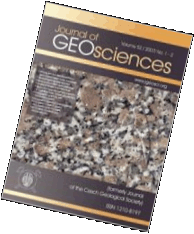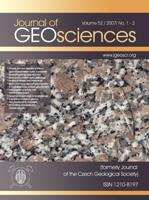 Export to Mendeley
Export to MendeleyBohemian Massif
High-pressure granulites
P-T path
zircon dating
protolith
tectonic processes
More articles on Deep crustal metamorphism and lower-crustal/upper-mantle processes
Review Paper
High-pressure granulites of the Bohemian Massif: recent advances and open questions
Journal of Geosciences, volume 52 (2007), issue 1-2, 45 - 71
DOI: http://doi.org/10.3190/jgeosci.006
This paper presents a summary of recent knowledge on the high-pressure (HP) granulites of the Bohemian Massif, focusing mainly on the felsic ones with the peak mineral assemblage garnet-kyanite-ternary feldspar-quartz. There are several lines of evidence for the HP character of these rocks, such as the coexistence of kyanite, ternary feldspar, garnet and rutile, high grossular content in garnet indicative of operation of the reaction An = Grs + Ky + Qtz and geothermobarometric constraints, as well as association with eclogites, mantle ultramafic rocks and ultra-high-pressure crustal rocks. Established mineral reactions and major-element zoning of garnet are indicative of post-peak decompression and cooling of granulites. Exhumation-related P-T path can be reconstructed using these, along with the P-T estimates for successive mineral assemblages in case they are preserved. Published P-T paths for the HP granulites of the Bohemian Massif are in general dominated by initial near-to-isothermal decompression, followed by near-to-isobaric cooling stage. However, the peak and post-peak history of some granulite bodies differs from this Moldanubian-type evolution. Mostly concordant U-Pb ages for spherical "metamorphic" zircon cluster around ~ 340 Ma. Arguments for the more common interpretation of this age as dating the HP granulite phase or the alternative one attributing it to the medium-pressure stage are listed. Fitting the P-T estimates to the age data from various geochronometers (P-T-t paths) allows exhumation and cooling rate of granulites to be constrained. Average exhumation rate calculated for the Bohemian HP granulites is at least 4 mm/yr, whereas the initial rate could be as high as 9-18 mm/yr. Initial cooling rate has been estimated at 25-100 °C/Myr. These high rates, but also preservation of the peak assemblages, reflect rapid exhumation of the HP granulite complexes of the Bohemian Massif.
It is still a matter of debate what were the protoliths of the felsic HP granulites; arguments for major HP melting period giving rise to these rocks and the alternative view of the granulites as metamorphosed granites (or orthogneisses) are presented. Tectonic scenarios for the HP granulites formation and exhumation can be subdivided into two groups: whereas some authors envisage deep Early Variscan subduction and subsequent thrusting and/or buoyancy-driven exhumation, the others postulate granulite formation due to the homogeneous crustal thickening and their exhumation through vertical extrusion of the orogenic lower crust.
Webdesign inspired by aTeo. Hosted at the server of the Institute of Petrology and Structural Geology, Charles University, Prague.
ISSN: 1803-1943 (online), 1802-6222 (print)
email: jgeosci(at)jgeosci.org


IF (WoS, 2024): 1.3
5 YEAR IF (WoS, 2024): 1.4
Policy: Open Access
ISSN: 1802-6222
E-ISSN: 1803-1943